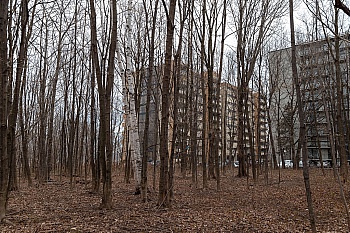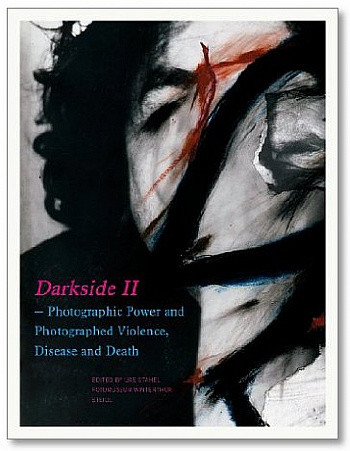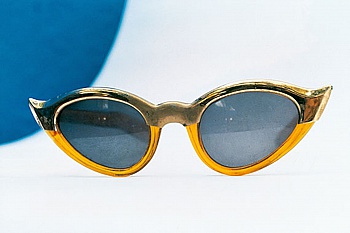
Ishiuchi Miyako
#Photographe
- Livre
Ciel variable vous invite au lancement de CV103 – NATURE
 Ciel variable vous invite au lancement de CV103 – NATURE qui présente les travaux de Jessica Auer, Geneviève Chevalier et Isabelle Hayeur. Trois pratiques qui questionnent les interrelations entre la ville et son environnement naturel.
© Jessica Auer, "Dusk (January 26th)", 2015, épreuve couleur
« Il y a des endroits où la présence de la nature se fait plus vivement sentir, des lieux où la question des interrelations entre la ville et son environnement naturel émerge plus spontanément. certaines circonstances sont également propices à susciter de telles réflexions : le dépaysement entraîné par un séjour à l’étranger, la nette détérioration de l&rs...
Ciel variable vous invite au lancement de CV103 – NATURE qui présente les travaux de Jessica Auer, Geneviève Chevalier et Isabelle Hayeur. Trois pratiques qui questionnent les interrelations entre la ville et son environnement naturel.
© Jessica Auer, "Dusk (January 26th)", 2015, épreuve couleur
« Il y a des endroits où la présence de la nature se fait plus vivement sentir, des lieux où la question des interrelations entre la ville et son environnement naturel émerge plus spontanément. certaines circonstances sont également propices à susciter de telles réflexions : le dépaysement entraîné par un séjour à l’étranger, la nette détérioration de l&rs... - Livre
Darkside, Vol. 2: Photographic Power and Photographed Violence, Disease and Death
 Following the survey of photographed sexuality and lust in Darkside I, the other end of the physical spectrum is illuminated: the intimate affinity between death and photography – impairment, disease, degeneration, violence and death, pain, grief and loss. Recording death is, along with war reporting, one of photography’s original tasks. Pictures of horror are often shocking and yet “bestselling”. They provoke questions about exploitation, complicity and power relationships – infront of and behind the camera and in the photograph itself. Photography often provokes accusations that it aestheticizes misery, creating a “pornography of horror”. Enlightenment quickly turns into transfiguration, photographic enlightenment into commerce. Darkside I and II examine Eros and Thanatos in pi...
Following the survey of photographed sexuality and lust in Darkside I, the other end of the physical spectrum is illuminated: the intimate affinity between death and photography – impairment, disease, degeneration, violence and death, pain, grief and loss. Recording death is, along with war reporting, one of photography’s original tasks. Pictures of horror are often shocking and yet “bestselling”. They provoke questions about exploitation, complicity and power relationships – infront of and behind the camera and in the photograph itself. Photography often provokes accusations that it aestheticizes misery, creating a “pornography of horror”. Enlightenment quickly turns into transfiguration, photographic enlightenment into commerce. Darkside I and II examine Eros and Thanatos in pi... - Exposition
Getty Museum Presents Ishiuchi Miyako : Postwar Shadows
 Self-taught photographer Ishiuchi Miyako (Japanese, born 1947) stunned the Japanese photography establishment in the late 1970s with grainy, haunting, black-and-white images of Yokosuka—the city where Ishiuchi spent her childhood and where the United States established an important naval base in 1945. Fusing the personal and political in her work, Ishiuchi interweaves her identity with the complex history of postwar Japan that emerged from “shadows” cast by American occupation. Presenting photographs made over the last forty years, this exhibition includes Ishiuchi’s most recent series, seventy years after the U.S. atomic bombing of Hiroshima and Nagasaki.
Ishiuchi Miyako , Japanese, born 1947, Yokosuka Story #73, 1976–1977, Gelatin silver print
43.7 x 53.7 cm (17 3/16 x 21 1/8 in...
Self-taught photographer Ishiuchi Miyako (Japanese, born 1947) stunned the Japanese photography establishment in the late 1970s with grainy, haunting, black-and-white images of Yokosuka—the city where Ishiuchi spent her childhood and where the United States established an important naval base in 1945. Fusing the personal and political in her work, Ishiuchi interweaves her identity with the complex history of postwar Japan that emerged from “shadows” cast by American occupation. Presenting photographs made over the last forty years, this exhibition includes Ishiuchi’s most recent series, seventy years after the U.S. atomic bombing of Hiroshima and Nagasaki.
Ishiuchi Miyako , Japanese, born 1947, Yokosuka Story #73, 1976–1977, Gelatin silver print
43.7 x 53.7 cm (17 3/16 x 21 1/8 in... - Exposition
New exhibition of Ishiuchi Miyako : « FRIDA » at Michael Hoppen Gallery
 Ishiuchi Miyako (b. 1947) is a celebrated Japanese photographer known for her poignant images confronting trauma in post war Japan. Her personal projects include Yokosuka Story, Apartment, Endless night, Mother's and Silken Dreams.
In 2005, she represented Japan at the Venice Biennale. In 2009, she received the 50th Mainichi Art Award and was invited to participate in the Third ICP Triennal in New York. Her Hiroshima series was exhibited at the Museum of Anthropology in Vancouver, Canada, from 2011 to 2012. In March 2014, she received the prestigious Hasselblad Haward. Her solo exhibition titled ' Postwar Shadows' opens at the Getty Museum in Los Angeles in October this year.
© Ishiuchi Miyako / Michael Hoppen Gallery
© Ishiuchi Miyako / Michael Hoppen Gallery
Frida by Ishiuch...
Ishiuchi Miyako (b. 1947) is a celebrated Japanese photographer known for her poignant images confronting trauma in post war Japan. Her personal projects include Yokosuka Story, Apartment, Endless night, Mother's and Silken Dreams.
In 2005, she represented Japan at the Venice Biennale. In 2009, she received the 50th Mainichi Art Award and was invited to participate in the Third ICP Triennal in New York. Her Hiroshima series was exhibited at the Museum of Anthropology in Vancouver, Canada, from 2011 to 2012. In March 2014, she received the prestigious Hasselblad Haward. Her solo exhibition titled ' Postwar Shadows' opens at the Getty Museum in Los Angeles in October this year.
© Ishiuchi Miyako / Michael Hoppen Gallery
© Ishiuchi Miyako / Michael Hoppen Gallery
Frida by Ishiuch... - Exposition
DARK SIDE 2 - Photographic Power and Violence, Disease and Death Photographed
 Following the investigation of photographed sexuality and desire in Darkside I, Fotomuseum Winterthur focuses now on the other extreme of the bodily spectrum, charting the path from the body as a veritable ‘picture of health’ to the body injured, disfigured or mutilated, in decline and decay. This raises questions: Why is there an intimate affinity between photography and death? Why does violence attract images? The visual world of western culture is full of images of violence – both random outbursts of violence and military violence, regulative state violence. In a strange reversal, societies have shut away images of life-affirming, life-giving sexuality, banishing them to the fringes of obscurity, whereas images of dark and excessive violence have been brought into the light. The reasons for this are ...
Following the investigation of photographed sexuality and desire in Darkside I, Fotomuseum Winterthur focuses now on the other extreme of the bodily spectrum, charting the path from the body as a veritable ‘picture of health’ to the body injured, disfigured or mutilated, in decline and decay. This raises questions: Why is there an intimate affinity between photography and death? Why does violence attract images? The visual world of western culture is full of images of violence – both random outbursts of violence and military violence, regulative state violence. In a strange reversal, societies have shut away images of life-affirming, life-giving sexuality, banishing them to the fringes of obscurity, whereas images of dark and excessive violence have been brought into the light. The reasons for this are ...
Modifier l'image
 Ciel variable vous invite au lancement de CV103 – NATURE qui présente les travaux de Jessica Auer, Geneviève Chevalier et Isabelle Hayeur. Trois pratiques qui questionnent les interrelations entre la ville et son environnement naturel.
© Jessica Auer, "Dusk (January 26th)", 2015, épreuve couleur
« Il y a des endroits où la présence de la nature se fait plus vivement sentir, des lieux où la question des interrelations entre la ville et son environnement naturel émerge plus spontanément. certaines circonstances sont également propices à susciter de telles réflexions : le dépaysement entraîné par un séjour à l’étranger, la nette détérioration de l&rs...
Ciel variable vous invite au lancement de CV103 – NATURE qui présente les travaux de Jessica Auer, Geneviève Chevalier et Isabelle Hayeur. Trois pratiques qui questionnent les interrelations entre la ville et son environnement naturel.
© Jessica Auer, "Dusk (January 26th)", 2015, épreuve couleur
« Il y a des endroits où la présence de la nature se fait plus vivement sentir, des lieux où la question des interrelations entre la ville et son environnement naturel émerge plus spontanément. certaines circonstances sont également propices à susciter de telles réflexions : le dépaysement entraîné par un séjour à l’étranger, la nette détérioration de l&rs... Following the survey of photographed sexuality and lust in Darkside I, the other end of the physical spectrum is illuminated: the intimate affinity between death and photography – impairment, disease, degeneration, violence and death, pain, grief and loss. Recording death is, along with war reporting, one of photography’s original tasks. Pictures of horror are often shocking and yet “bestselling”. They provoke questions about exploitation, complicity and power relationships – infront of and behind the camera and in the photograph itself. Photography often provokes accusations that it aestheticizes misery, creating a “pornography of horror”. Enlightenment quickly turns into transfiguration, photographic enlightenment into commerce. Darkside I and II examine Eros and Thanatos in pi...
Following the survey of photographed sexuality and lust in Darkside I, the other end of the physical spectrum is illuminated: the intimate affinity between death and photography – impairment, disease, degeneration, violence and death, pain, grief and loss. Recording death is, along with war reporting, one of photography’s original tasks. Pictures of horror are often shocking and yet “bestselling”. They provoke questions about exploitation, complicity and power relationships – infront of and behind the camera and in the photograph itself. Photography often provokes accusations that it aestheticizes misery, creating a “pornography of horror”. Enlightenment quickly turns into transfiguration, photographic enlightenment into commerce. Darkside I and II examine Eros and Thanatos in pi... Self-taught photographer Ishiuchi Miyako (Japanese, born 1947) stunned the Japanese photography establishment in the late 1970s with grainy, haunting, black-and-white images of Yokosuka—the city where Ishiuchi spent her childhood and where the United States established an important naval base in 1945. Fusing the personal and political in her work, Ishiuchi interweaves her identity with the complex history of postwar Japan that emerged from “shadows” cast by American occupation. Presenting photographs made over the last forty years, this exhibition includes Ishiuchi’s most recent series, seventy years after the U.S. atomic bombing of Hiroshima and Nagasaki.
Ishiuchi Miyako , Japanese, born 1947, Yokosuka Story #73, 1976–1977, Gelatin silver print
43.7 x 53.7 cm (17 3/16 x 21 1/8 in...
Self-taught photographer Ishiuchi Miyako (Japanese, born 1947) stunned the Japanese photography establishment in the late 1970s with grainy, haunting, black-and-white images of Yokosuka—the city where Ishiuchi spent her childhood and where the United States established an important naval base in 1945. Fusing the personal and political in her work, Ishiuchi interweaves her identity with the complex history of postwar Japan that emerged from “shadows” cast by American occupation. Presenting photographs made over the last forty years, this exhibition includes Ishiuchi’s most recent series, seventy years after the U.S. atomic bombing of Hiroshima and Nagasaki.
Ishiuchi Miyako , Japanese, born 1947, Yokosuka Story #73, 1976–1977, Gelatin silver print
43.7 x 53.7 cm (17 3/16 x 21 1/8 in... Ishiuchi Miyako (b. 1947) is a celebrated Japanese photographer known for her poignant images confronting trauma in post war Japan. Her personal projects include Yokosuka Story, Apartment, Endless night, Mother's and Silken Dreams.
In 2005, she represented Japan at the Venice Biennale. In 2009, she received the 50th Mainichi Art Award and was invited to participate in the Third ICP Triennal in New York. Her Hiroshima series was exhibited at the Museum of Anthropology in Vancouver, Canada, from 2011 to 2012. In March 2014, she received the prestigious Hasselblad Haward. Her solo exhibition titled ' Postwar Shadows' opens at the Getty Museum in Los Angeles in October this year.
© Ishiuchi Miyako / Michael Hoppen Gallery
© Ishiuchi Miyako / Michael Hoppen Gallery
Frida by Ishiuch...
Ishiuchi Miyako (b. 1947) is a celebrated Japanese photographer known for her poignant images confronting trauma in post war Japan. Her personal projects include Yokosuka Story, Apartment, Endless night, Mother's and Silken Dreams.
In 2005, she represented Japan at the Venice Biennale. In 2009, she received the 50th Mainichi Art Award and was invited to participate in the Third ICP Triennal in New York. Her Hiroshima series was exhibited at the Museum of Anthropology in Vancouver, Canada, from 2011 to 2012. In March 2014, she received the prestigious Hasselblad Haward. Her solo exhibition titled ' Postwar Shadows' opens at the Getty Museum in Los Angeles in October this year.
© Ishiuchi Miyako / Michael Hoppen Gallery
© Ishiuchi Miyako / Michael Hoppen Gallery
Frida by Ishiuch... Following the investigation of photographed sexuality and desire in Darkside I, Fotomuseum Winterthur focuses now on the other extreme of the bodily spectrum, charting the path from the body as a veritable ‘picture of health’ to the body injured, disfigured or mutilated, in decline and decay. This raises questions: Why is there an intimate affinity between photography and death? Why does violence attract images? The visual world of western culture is full of images of violence – both random outbursts of violence and military violence, regulative state violence. In a strange reversal, societies have shut away images of life-affirming, life-giving sexuality, banishing them to the fringes of obscurity, whereas images of dark and excessive violence have been brought into the light. The reasons for this are ...
Following the investigation of photographed sexuality and desire in Darkside I, Fotomuseum Winterthur focuses now on the other extreme of the bodily spectrum, charting the path from the body as a veritable ‘picture of health’ to the body injured, disfigured or mutilated, in decline and decay. This raises questions: Why is there an intimate affinity between photography and death? Why does violence attract images? The visual world of western culture is full of images of violence – both random outbursts of violence and military violence, regulative state violence. In a strange reversal, societies have shut away images of life-affirming, life-giving sexuality, banishing them to the fringes of obscurity, whereas images of dark and excessive violence have been brought into the light. The reasons for this are ...